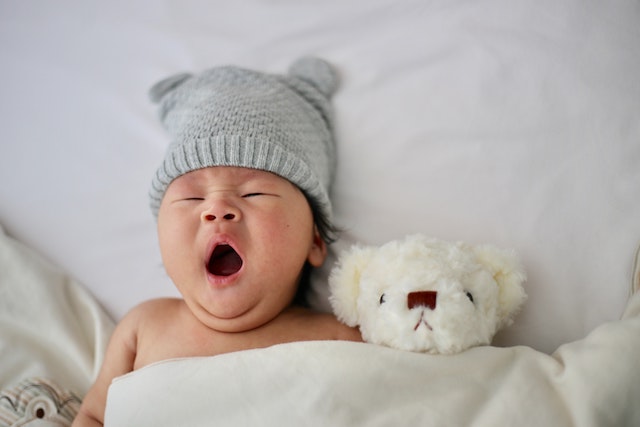From fevers to teething, Dr Jenifer Worden describes how she treats infants & small children homeopathically
New-born babies can appear vulnerable and fragile creatures yet they quickly grow into sturdy and occasionally troublesome toddlers, as any weary parent can tell you! One of the most rewarding tasks of being a GP is being able to reassure the worried new mother that her baby will make a full recovery from its illness. However, the scariest times that I have experienced as a doctor have been with seriously ill children. When babies and toddlers become unwell, they can do so rapidly, but can also recover just as quickly.
There are certain situations when a sick child should always be seen by a doctor urgently, by emergency ambulance if necessary, such as:
a persistent high fever with constant vomiting or diarrhoea;
-
-
- a rash which does not go pale when a glass is held firmly on it;
- a floppy child;
- one not responding to your voice consistently;
- an unconscious child.
-
However, if a child has a raised temperature but is able to chat to you or respond in a normal way and is eating or drinking to a certain extent, then your local GP surgery or out-of-hours service should be able to help you.
Doctor’s surgeries these days will often offer a telephone consultation first, as simple advice regarding ways to help a sick child can be given in this way. It also helps the doctor decide how urgently the child needs to be seen and an appropriate appointment made for later that day or whenever it is needed. This should mean parents avoid waiting for long times in a crowded waiting room with a sick, miserable baby.
Contrary to popular belief, no harm will come to a feverish baby or toddler from being taken out in the cold to visit the GP; it actually helps as the cooler air outside helps reduce the child’s temperature and that makes the little one feel better. This tends to make examination easier by the GP as the child is not so fractious and makes it much simpler to make an accurate diagnosis. As a doctor, I have had many experiences of trying to look in the ears of a very fed up and hot one year-old and parents find it very hard to hold a struggling baby who is determined not to let anyone near it. A more comfortable and happier child will co-operate much more willingly.
Homeopathic treatment
So how can homeopathy help with a child that is unwell? How can such an old-fashioned therapy be so relevant in today’s technological age?
Well, as I have just been discussing fever as a symptom, it would seem a good place to start. There are a number of homeopathic medications that can be safely given to a feverish child, either as a sole therapy or as a holding measure whilst waiting to see the doctor. It is important to mention that all homeopathic medicines can be given alongside any conventional medications that a baby or toddler may also be taking, either regular medications for an ongoing complaint or medicines given just for that illness, such as paracetamol or ibuprofen syrup.
The normal temperature of a child is the same as that of an adult, 36.8 degrees centigrade, and a simple cold or tummy upset will often cause what doctors refer to as a “low-grade” fever of 37.5 degrees centigrade or less. A bacterial ear infection may cause a higher temperature of 38 to 39 degrees centigrade. A temperature of 40 degrees centigrade which persists for longer than an hour or so could indicate a more serious infection needing urgent medical assessment. A fever as a response to illness is a good sign as it shows the immune system is working correctly. Yet fever often seems to worry parents, perhaps because of the association of a high temperature with serious illnesses such as pneumonia or meningitis; such severe infections are relatively rare. Fevers are part of a child growing up and there is increasing evidence that simple infections help prime the body’s immune system to fight off more serious illnesses. So it is not necessary to avoid every bacterium or virus, as the manufacturers of disinfectants would perhaps have us believe. Temperatures can be easily checked by a forehead thermometer, easily obtained from pharmacies.
Fevers
The most commonly used remedy for fever in a child is Belladonna. This medication is produced from the deadly nightshade plant and is suitable for conditions that come on suddenly and severely and then subside as quickly. A high fever develops, with burning skin, with a hot head, often radiating heat, whilst the feet and hands are cool to the touch. The baby or toddler looks hot or flushed, with a slightly glazed look in their eyes; the toddler may appear delirious and babble incoherently. Their skin feels dry to the touch and they either refuse all drinks or want to drink incessantly. I used this remedy very successfully with my own daughter when she was little, with a 30c tablet being given every two hours until she was better. This is a typical picture of fever due to simple viral coughs or colds. It is important to add that if a homeopathic medication does not appear to be helping, then it is advisable to use conventional medicine. However, as a doctor, I would advise that parents try to avoid any overthe-counter medication containing a sedative as this could possibly disguise symptoms due to a worsening illness and makes assessment of a sick child difficult by the health professional.
Teething
Chamomilla, from the wild chamomile plant, is another medicine to keep close at hand in the medicine cabinet if you are a parent or grandparent. As well as being recommended for ear infections, and the associated illness, it is invaluable for teething symptoms. Teething in itself does not cause a temperature, but very often accompanies a cold or cough, so results in a very unhappy baby or toddler with a sore mouth and low grade fever. The child often has one very hot cheek and, unlike the Belladonna picture of fear and delirium, is very fractious and angry. First of all, they want to be picked up, and then they want to be put down. It is hard to placate them as they do not know what they want; the only thing that will help is either to carry them or to rock them. A good rule of thumb when deciding whether your ill child will benefit from Chamomilla is that if they make you feel cross and angry and just looking at them throws the child into a temper tantrum, then Chamomilla is a good remedy to start with.
Colds
Carrying on with the theme of fever, as previously mentioned, one of the most common reasons for me to see a baby or toddler in my GP surgery is a simple cough or cold, what is referred to in medical practice as an “upper respiratory tract infection” or “URTI” for short.
Real colds in very young babies under the age of three months are relatively unusual, as they still have immunity to infections passed on to them in the womb from their mother, although they can become snuffly with an excess of nasal mucous, particularly if their nasal passages are narrow.
Until the age of five or six years old, children get between six to eight colds a year, and as each cold can last up to six weeks, then it becomes apparent that most little ones can spend a lot of time with a runny nose and feeling under the weather. The frequency of colds and the associated symptoms is a major cause for concern with parents, especially first time ones and I hope the above figures for normal children go some way to reassuring readers of this article. If a child does seem to be suffering from an excess of viral infections, but is continuing to grow normally (which tends to rule out a serious underlying problem) then a professional medically qualified homeopath can help with a constitutional remedy, one based on the child as a whole, rather than just on the symptoms of the acute illness.
Coughs
These are one of the main reasons for me to see a baby or toddler in my GP surgery. A good remedy for the chesty type of cough that often seems to follow a cold and which can be heard in classrooms and supermarkets up and down the country in the winter months is Pulsatilla. The reason I mention supermarkets is that when my children were little and off school with a cough I would take them shopping with me. It seemed that every other child had the same persistent cough and that up and down the supermarket aisles, the same wan faces were looking out over the top of the shopping trolleys.
If the ill child is oversensitive and tearful when unwell, wants to be looked after and made a fuss of and is very clingy with a need for constant cuddles, then Pulsatilla will probably help, especially if they feel worse in a warm room and want the window open for fresh air. Thick yellow catarrh runs from their nose, and they often have a concurrent conjunctivitis. The cough associated with Pulsatilla is worse at night on lying down, preventing or disturbing their sleep. One noticeable feature of Pulsatilla is that it is very difficult to persuade the children to drink; even when not ill, they are often relatively thirstless.
If the cough is dry and of the tickly type, which exhausts the child or a hard, barking cough made worse by laughing or talking, then it is worth considering Phosphorus. Like the Pulsatilla children, Phosphorus children are sensitive, but tend to feel the cold rather than the heat and are very thirsty, especially for iced drinks. They love ice cream when they are ill and can be troubled with nose bleeds when suffering from a cough or a cold. Their cough may be triggered by a change of atmosphere or temperature. The cough associated with the Phosphorus remedy can be similar to that of asthma, with wheeziness, and an older toddler may complain of some chest pain due to constriction of their airways. Phosphorus children are normally intelligent and affectionate but can be easily tired and liable to become moody.
Bryonia, made from white bryony, was one of the first remedies tested, (proved) by the founder of modern homeopathy, Samuel Hahnemann. Coughs that respond well to Bryonia tend to come on after exposure to the cold and are dry, like the Phosphorus cough. There is also thirst for cold drinks but children doing well with Bryonia will tend to be more irritable and dislike being moved. They prefer to be left alone in the quiet, whereas Phosphorus children want company. Colds may travel down to their chests and result in a worsening of asthma, if it is a pre-existing condition.
Over-the-counter medicines
Many parents use cough medicines bought from the pharmacy but these are often ineffective and were taken off the prescribing list for family doctors by the government some years ago because of this fact.
A cough is the natural response of an inflamed throat or infected lungs to the presence of swollen tissues, phlegm or pus and so it is necessary to treat the underlying cause rather than the symptom. A soothing cough medicine, such a home-made honey and lemon syrup, can help reduce the dryness of a sore throat but is largely ineffective with a chesty cough due to phlegm dripping down the back of the throat. This is particularly true on lying down at night.
Decongestant cough medicines, designed to treat chesty coughs, are currently recommended only for children aged two years old and over, following recent safety scares in the US. Labelling will be changed by the UK suppliers of such medications by October 2008, advising that cough medicines should only be given to children under the age of two after consulting a doctor – even more reason to use homeopathy for sick children with minor self-limiting illnesses as detailed above!






